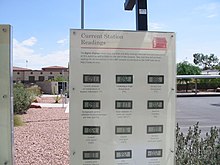Roentgen (unit): Difference between revisions
→Exposure: "Usually lethel" is a vital expression, because these things are strictly PROBABALISTIC ! |
→Exposure: ABOUT 23 microroentgens per hour, because this number is NOT known exactly, nor should it be. |
||
| Line 15: | Line 15: | ||
On this scale an exposure of about 500 roentgens in five hours is usually lethal for [[human beings]]. |
On this scale an exposure of about 500 roentgens in five hours is usually lethal for [[human beings]]. |
||
A typical exposure of normal [[background radiation]] for a human being is about 200 |
A typical exposure of normal [[background radiation]] for a human being is about 200 miiliroentgens per year, or about 23 microroentgens per hour. |
||
==See also== |
==See also== |
||
Revision as of 13:58, 27 March 2011
The roentgen (R, also röntgen) is a unit of measurement for exposure to ionizing radiation (such as X-ray and gamma rays), and is named after the German physicist Wilhelm Röntgen. Adopted in 1928[1], 1 R is the amount of radiation required to liberate positive and negative charges of one electrostatic unit of charge (esu) in 1 cm³ of dry air at standard temperature and pressure (STP). This corresponds to the generation of approximately 2.08×109 ion pairs.
Until 2006, the roentgen was accepted for use with the SI system but its value is expressed in terms of the SI units charge divided by unit mass (C/kg) rather than as in the original definition. Although its use was allowable under the SI system, it is not itself an SI unit and its continued use is "strongly discouraged" by the National Institute of Standards and Technology style guide for NIST authors.[2]
Explanation

The roentgen was occasionally used to measure exposure to radiation in forms other than X-rays or gamma rays. To adjust for the different impact of different forms of radiation on biological matter, "roentgen equivalent man" or rem was also in use. Exposure in rems is equal to the exposure in roentgens multiplied by the Q value, a constant describing the type of radiation. The rem is now superseded by the sievert (see the latter for a list of Q values).
Conversion
In SI units, 1 R = 2.58×10−4 C/kg (from 1 esu ≈ 3.33564×10−10 C and the standard atmosphere air density of ~1.293 kg/m³).[2]
Exposure
On this scale an exposure of about 500 roentgens in five hours is usually lethal for human beings.
A typical exposure of normal background radiation for a human being is about 200 miiliroentgens per year, or about 23 microroentgens per hour.
See also
- Wilhelm Conrad Röntgen
- rad (unit) — c.g.s. unit of absorbed dose
- Gray (unit) — SI unit of absorbed dose
- Roentgen equivalent man, or rem, a unit of radiation dose equivalent
- Sievert — The sievert (symbol: Sv) is the SI derived unit of dose equivalent.
- Microdose
- Orders of magnitude (radiation)
References
- ^ Van Loon, R.; and Van Tiggelen, R., Radiation Dosimetry in Medical Exposure: A Short Historical Overview, 2004>
- ^ a b Taylor, BN, "Units temporarily accepted for use with the SI", NIST Guide for the Use of the International System of Units (SI), chapter 5, Physics Laboratory Publications, April 1995, retrieved and archived [1] 12th June 2008
